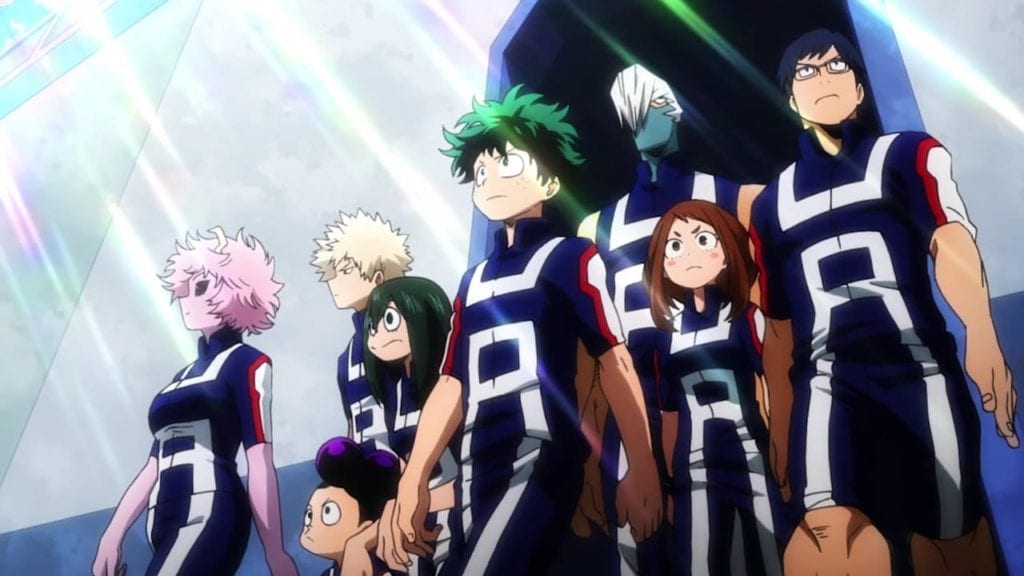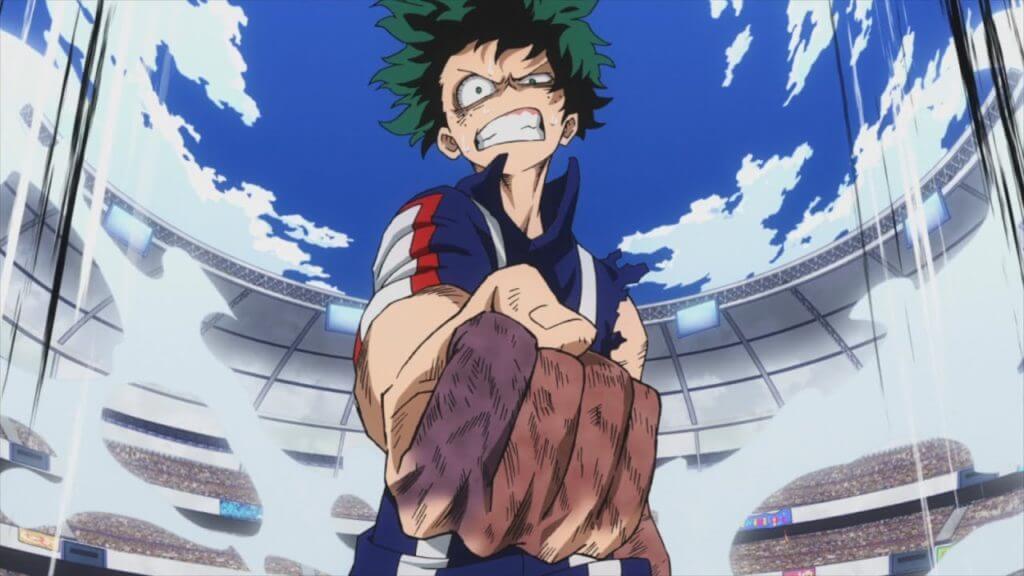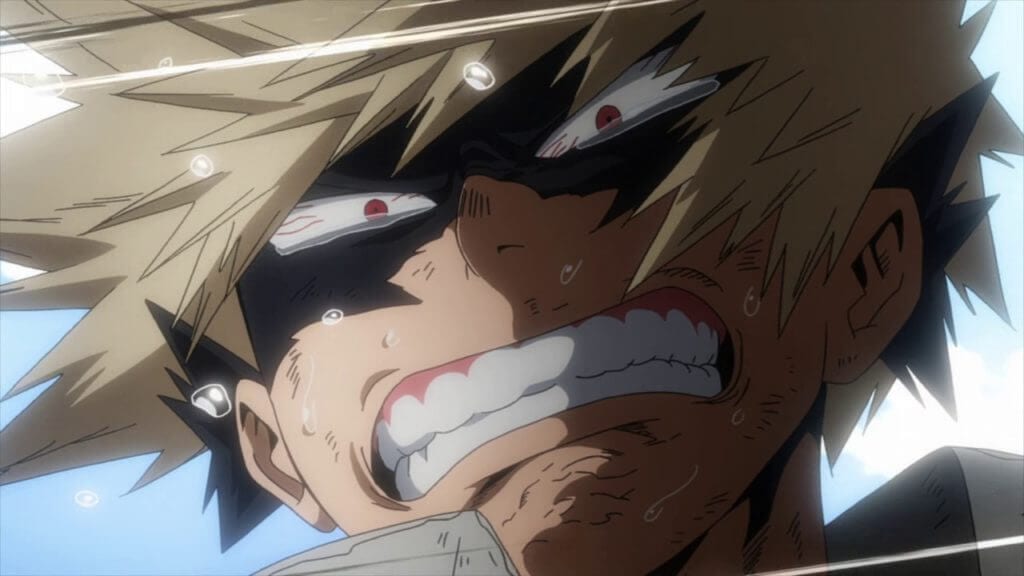REVIEW: My Hero Academia Season 2 (2017)
In my review of season 1, I mentioned that My Hero Academia had the potential to be something great. I loved the foundation that was set and wanted to see some payoff in the story for all the time spent establishing the world and its main characters. I didn’t expect it to be this good, though; I didn’t expect this season to continue doing what made season 1 great while improving in every way possible. My Hero Academia season 2 is a game changer. It’s impossible for me to really speak about the show without some spoilers so proceed with caution!
*Spoilers*
My Hero Academia season 2 is split into three different arcs, the first of which is the school festival arc. This is easily my favorite story arc in the series so far because the execution is absolutely spot on. The students of U.A. have to take part in a school festival that the world will be watching. Since quirks became a normal thing in society, events like the Olympics grew less and less popular. As a result, the public chooses to tune in to the annual sports festival as a way to figure out what the next generation of heroes will look like.

The sports festival in My Hero Academia season 2 has several preliminary events and culminates with a 16-person single elimination tournament. The brilliance of this arc is how every step of the school festival is used to develop the characters. Several people who were in the background in season 1 take center stage so that we can understand them better. For example, Todoroki is one of the top students in Midoriya’s class (class 1-A). He didn’t get too much screen time in season 1, but it was clear that he was extremely powerful. Bakugo even mentioned that he couldn’t beat Todoroki after watching him win a team training exercise with ease. During the festival, Todoroki quickly becomes one of the most important characters in the series. This is because his story is quite tragic. He is the son of the number 2 hero in the world, Endeavor. Endeavor was never able to supercede All Might as the number 1 hero so he decided that he wanted his son to eventually achieve what he couldn’t. There are these things called quirk marriages, which is when two people get married with the sole purpose of having a child with a specific quirk. Endeavor can use fire, and he found a woman who has the power to use ice, so Todoroki came out with a quirk allowing him to use both. Todoroki’s mom hatted Endeavor and saw him whenever she looked into Todoroki’s eyes. That hate he got from his mother fueled Todoroki’s lifelong resentment of his father, causing him never to use the fire power he inherited from him. Despite his hate for Endeavor, however, he still plans on becoming the number 1 hero. This makes Midoriya his primary target, being that All Might is especially fond of him.
This idea of rejecting one’s lineage is the exact opposite of one of the other classmates, Tenya Iida. He comes from a family of heroes and hopes to one day carry on the family legacy and make them proud. He wants to use this sports festival as a way to impress them. The last notable character here is Ochaco Uraraka. She is one of Midoriya’s best friends and an all around good person. When asked why she even wants to be a hero she gives an answer that she believes sounds less noble when compared to Iida and Midoriya. Ochaco’s parents have a construction company that is losing business and Ochaco has the ability to manipulate gravity, so becoming a pro would allow her to help out her parents’ company and make their lives easier. When you add these ideologies to Midoriya’s drive to become All Might’s successor, and Bakugo’s unstoppable desire to win, you get a tournament that means so much more than the punches that are thrown. This, to me, is the most compelling way to do action. While amazing and intricate choreography is fantastic, it’s the emotional weight of each fist that really determines the lasting impact a particular fight will have. By the time we get to the tournament, it feels as if the weight of the world is going to be put into every fight.

Before we get there, though, the characters have to make it through the preliminary contests. The first contest is an obstacle course that quickly helps to remind us how resourceful Midoriya is. He can’t use his quirk too early because of the limited control he has over it, so he is left using the environment to his advantage as best he can. The strategy he employs at the end of the race – to stack landmines on top of each other and blast himself ahead of everyone else – is genius. The next event is the cavalry battle. The students compete in teams of four that they get to choose, with the goal of snatching headbands off of the opposing teams. Each headband has a different point total that is determined by their placing in the previous event. The four teams with the most points will advance to the tournament. I really enjoyed every bit of this contest. The stronger students like Todoroki and Bakugo are able to get teams fast, but Midoriya doesn’t have many people willing to be on his. This is, once again, a way for Midoriya to show off how strategic he can be. He puts together a team of students that weren’t anyone’s first pick, but who can still get the job done. This also works as a way to let a character like Tokoyami shine. Up to this point, he’s been in the background, and his quirk hasn’t been fully explained. This is where he gets to show that more people should probably be paying attention to him.
Finally, we get to the tournament. The thing I love most about this tournament is how My Hero Academia season 2 handles its pacing. There are plenty of fights here that don’t have much significance at all. Instead of drawing these fights out, they last long enough to be entertaining without ever overstaying their welcome. Considering this whole arc lasts 12 episodes, it’s important to use that time wisely. It also makes the fights that do last longer mean that much more. There are two fights that I feel need to be talked about in depth. The first is Ochaco vs. Bakugo in the first round of the tournament; Bakugo is an overwhelming favorite in this fight, while Ochaco is completely unsure if she can win. Despite this, she refuses help from anyone in prepping for the match. During the fight, it’s clear that she’s no match for Bakugo, but her drive to provide for her family keeps her going. This is a level of heightened drama that the series hadn’t reached yet. With every move she makes, and every blast she takes, it’s clear that she’s trying to win. Even Bakugo is able to identify that he’s in a much tougher fight than he’d ever imagined. From a spectator’s view, it looks like Bakugo is toying with her, but Bakugo knows he’s one wrong move away from losing. This is a fantastic way to establish Ochaco as someone with the potential to be a great fighter down the road, and the ending of this fight leaves a lasting impression.
The other fight I need to talk about is Midoriya vs. Todoroki in the second round of the tournament. Put simply, this fight is absolute perfection. This is a series-defining moment for My Hero Academia because it accomplishes so much. Midoriya wants to be a symbol of peace like All Might is, so when he sees how Todoroki is struggling with his family issues, he uses this fight as an opportunity to make Todoroki realize that his father doesn’t define who he is. The animation is beautiful, the voice acting is brilliant, and the emotions run sky high. By the time we reach the end of the fight, the result really doesn’t matter; Midoriya has taken his biggest step so far toward becoming the hero he wants to be, and Todoroki’s entire ideology is shaken to its core. This is fantastic writing and absolutely crucial for both of their development.

After the tournament is over, the students get offers for internships from hero agencies depending on how they performed at the school festival. Some of the internships aren’t at all what the students think, while others give them more experience than they could’ve asked for. The most important thing to come out of this arc, though, is the introduction of Stain. Till this point in the series, the divide between heroes and villains has been black and white. Once Stain enters My Hero Academia season 2, that all changes. Stain is a villain that goes from city to city killing heroes. He believes that most of the people who call themselves heroes don’t deserve that title because all they want is riches and fame. He has devoted his life to cleaning up the streets that he feels are infested with false heroes. His methods are showing results too; every city he’s been to has seen a heavy decrease in crime. He has a clear influence on society. His philosophy also calls into question what being a villain actually means in this world. Stain is not a good guy by any stretch, but someone like Endeavor can do some truly horrible things and still be considered the world’s number 2 hero. By looking at it that way, it appears that, in this world, a villain is just someone that challenges the status quo. Stain disagrees with the way society is constructed and has decided to do something about it.
The eventual meeting between Stain and a few of the U.A. students is another highlight of My Hero Academia season 2. This is especially true for Iida, who has personal stakes in the fight. This is also the longest action sequence in the show so far. Pretty much all of the previous fights have been straight up brawls, but this one has a little more fight choreography involved while still having the emotional weight of the encounter be the driving force. Stain is a fascinating character that fits into this world in a way that no one else does. He’s a villain with convictions that are so strong it’s almost terrifying. He’s someone the heroes can understand, even if they don’t necessarily agree with his beliefs.

The final arc of My Hero Academia season 2 is the final exam arc. The students get separated into teams of two and must fight one of the U.A. teachers. This is easily the weakest of the three arcs and offers the least amount of substance. There are still a few great moments, like watching Yaoyorozu gaining some of her confidence back after losing it all in the school festival. The most important part is when Midoriya and Bakugo have to team up against All Might. After watching how poorly Midoriya and Bakugo get along, their teacher Eraserhead decides it would be best to put them together as a team. The fight is entertaining for sure, but the insight that we get into Bakugo’s psychology is what makes it great. Bakugo has played a significant role in My Hero Academia season 2, but this is the first time he’s received any real character development. His answer for what being a hero means is extremely simple compared to most of the others, but it’s a driving force that he’s willing to die for. Midoriya has been around Bakugo since they were kids, but this is the moment where he really understands what makes Bakugo tick. It also means that, now that he has this knowledge, Midoriya won’t ever let Bakugo stray from it because Bakugo would be betraying himself. It’s a great sequence that ends the season on a positive note.

On the technical side of things, not much has changed from season 1. Everything stays fantastic, especially the voice acting. Christopher Sabat is still amazing as All Might. Justin Briner deserves even more credit in My Hero Academia season 2, though. His performance during the fight against Todoroki gave me goosebumps. There are also a few more notable actors I feel need to be mentioned. Luci Christian as Ochaco Uraraka is spot on; I don’t think there’s a voice actress out there that can capture bubbly personalities the way she can. J. Michael Tatum as Tenya Iida is perfect casting, as his stern voice helps the “so serious he’s hilarious” personality of the character. There’s a moment during the Stain fight where I sensed his vulnerability, and the pain in his voice is communicated so clearly. Robert McCollum as Stain is intense, to say the least; it feels like he believes every word he says. Lastly, David Matranga as Shoto Todoroki is fantastic. The quiet delivery really gives him a mysterious edge. Finally – I said it in my review for season 1, but I definitely have to mention it again – Colleen Clinkenbeard deserves a lot of credit as the ADR Director. This is such a big cast of characters that will likely continue to grow, yet each voice is still unique and so well realized. She also voices Momo Yaoyorozu, which I think is a perfect match.
This is exactly what I wanted to see from My Hero Academia season 2. The writing has gotten even better while including even more likable characters. The school festival arc is one of anime’s best tournament arcs in a very long time. Stain is a character that eliminates the simplicity of where heroes and villains fall in this world. Unlike the other villains introduced so far, he has a motivation that is a lot more than killing people for the sake of killing. My Hero Academia works so well because the characters come before anything. The fights have meaning, and the action only happens as a result of that. Moving forward, I have high expectations. I’m not sure if season 3 can match the quality here, but I’ll certainly tune in to find out.
My Hero Academia
Plot - 9
Acting - 10
Progression - 10
Product Design - 10
Animation - 9.5
9.7
Outstanding
My Hero Academia Season 2 improves on the first in every possible way. The characters are better and the action is emotional. The sky is the limit for this anime.







